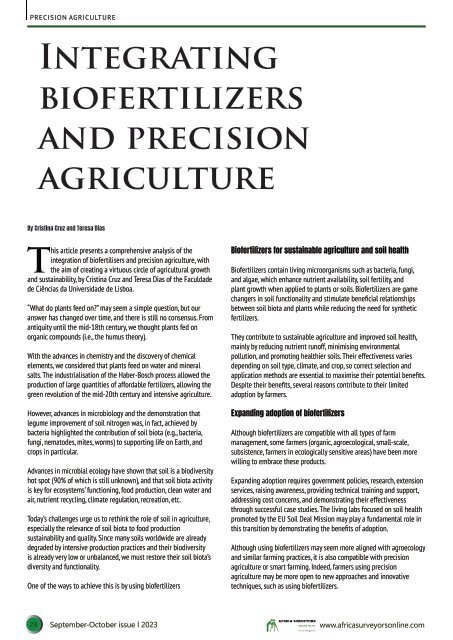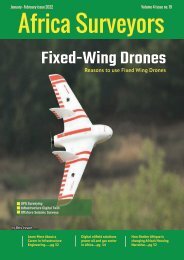Africa Surveyors September-October issue 2023
Africa Surveyors is Africa’s premier source of Surveying, Mapping and Geospatial news and an envoy of surveying products/service for the Construction, Maritime, Onshore & Offshore energy and exploration, Engineering, Oil and Gas, Agricultural and Mining sectors on new solution based trends and technology for the African market.
Africa Surveyors is Africa’s premier source of Surveying, Mapping and Geospatial news and an envoy of surveying products/service for the Construction, Maritime, Onshore & Offshore energy and exploration, Engineering, Oil and Gas, Agricultural and Mining sectors on new solution based trends and technology for the African market.
- TAGS
- marinesurveys
- geospatialmapping
- precisionagriculture
- 3dfusion
- climatechange
- africa
- africasurveyors
- dronesinafrica
- norbitsubsea
- norbitmultibeam
- seismicsurveys
- dronesurveying
- seafloormapping
- offshoresurveys
- quantitysurveyors
- underwaterrobotics
- subseasolutions
- hydographicsurvey
- multibeamandlidar
- gdansk
Create successful ePaper yourself
Turn your PDF publications into a flip-book with our unique Google optimized e-Paper software.
PRECISION AGRICULTURE<br />
Integrating<br />
biofertilizers<br />
and precision<br />
agriculture<br />
By Cristina Cruz and Teresa Dias<br />
This article presents a comprehensive analysis of the<br />
integration of biofertilisers and precision agriculture, with<br />
the aim of creating a virtuous circle of agricultural growth<br />
and sustainability, by Cristina Cruz and Teresa Dias of the Faculdade<br />
de Ciências da Universidade de Lisboa.<br />
“What do plants feed on?” may seem a simple question, but our<br />
answer has changed over time, and there is still no consensus. From<br />
antiquity until the mid-18th century, we thought plants fed on<br />
organic compounds (i.e., the humus theory).<br />
With the advances in chemistry and the discovery of chemical<br />
elements, we considered that plants feed on water and mineral<br />
salts. The industrialisation of the Haber-Bosch process allowed the<br />
production of large quantities of affordable fertilizers, allowing the<br />
green revolution of the mid-20th century and intensive agriculture.<br />
However, advances in microbiology and the demonstration that<br />
legume improvement of soil nitrogen was, in fact, achieved by<br />
bacteria highlighted the contribution of soil biota (e.g., bacteria,<br />
fungi, nematodes, mites, worms) to supporting life on Earth, and<br />
crops in particular.<br />
Advances in microbial ecology have shown that soil is a biodiversity<br />
hot spot (90% of which is still unknown), and that soil biota activity<br />
is key for ecosystems’ functioning, food production, clean water and<br />
air, nutrient recycling, climate regulation, recreation, etc.<br />
Today’s challenges urge us to rethink the role of soil in agriculture,<br />
especially the relevance of soil biota to food production<br />
sustainability and quality. Since many soils worldwide are already<br />
degraded by intensive production practices and their biodiversity<br />
is already very low or unbalanced, we must restore their soil biota’s<br />
diversity and functionality.<br />
One of the ways to achieve this is by using biofertilizers<br />
Biofertilizers for sustainable agriculture and soil health<br />
Biofertilizers contain living microorganisms such as bacteria, fungi,<br />
and algae, which enhance nutrient availability, soil fertility, and<br />
plant growth when applied to plants or soils. Biofertilizers are game<br />
changers in soil functionality and stimulate beneficial relationships<br />
between soil biota and plants while reducing the need for synthetic<br />
fertilizers.<br />
They contribute to sustainable agriculture and improved soil health,<br />
mainly by reducing nutrient runoff, minimising environmental<br />
pollution, and promoting healthier soils. Their effectiveness varies<br />
depending on soil type, climate, and crop, so correct selection and<br />
application methods are essential to maximise their potential benefits.<br />
Despite their benefits, several reasons contribute to their limited<br />
adoption by farmers.<br />
Expanding adoption of biofertilizers<br />
Although biofertilizers are compatible with all types of farm<br />
management, some farmers (organic, agroecological, small-scale,<br />
subsistence, farmers in ecologically sensitive areas) have been more<br />
willing to embrace these products.<br />
Expanding adoption requires government policies, research, extension<br />
services, raising awareness, providing technical training and support,<br />
addressing cost concerns, and demonstrating their effectiveness<br />
through successful case studies. The living labs focused on soil health<br />
promoted by the EU Soil Deal Mission may play a fundamental role in<br />
this transition by demonstrating the benefits of adoption.<br />
Although using biofertilizers may seem more aligned with agroecology<br />
and similar farming practices, it is also compatible with precision<br />
agriculture or smart farming. Indeed, farmers using precision<br />
agriculture may be more open to new approaches and innovative<br />
techniques, such as using biofertilizers.<br />
28 <strong>September</strong>-<strong>October</strong> <strong>issue</strong> l <strong>2023</strong> www.africasurveyorsonline.com
















